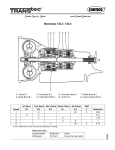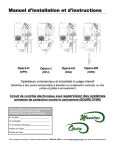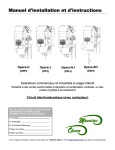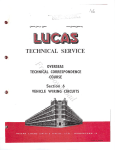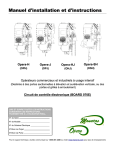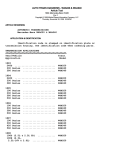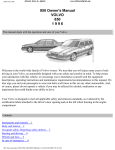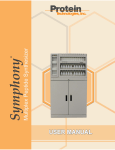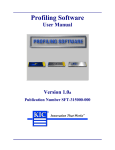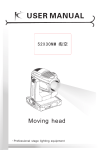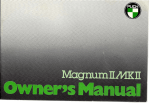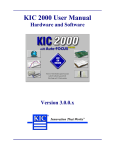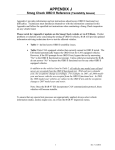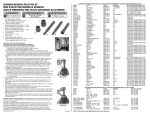Download Mercedes Benz 722 Series Automatic Transmission Service Manual
Transcript
AUTO TRANS DIAGNOSIS - 722 SERIES Article Text 1996 Mercedes-Benz C220 Copyright © 1998 Mitchell Repair Information Company, LLC Wednesday, January 26, 2000 12:03PM ARTICLE BEGINNING AUTOMATIC TRANSMISSIONS Mercedes-Benz 722 Series - Electronic Diagnosis C220, C280, C36, E300D, E320 E420, S320, S350D, S500, S600 SL320, SL500, SL600 APPLICATION & LABOR TIMES APPLICATION & LABOR TIMES Year/Vehicle Application Labor Times R & I (1) Overhaul (2) 1995 C220 ........ C280 ........ C36 ......... E300D ....... E320 ........ E420 ........ S320 ........ S350D ....... S500 ........ S600 ........ SL320 ....... SL500 ....... SL600 ....... 1996 C220 ........ C280 ........ C36 ......... E320 ........ E300D ....... S320 ........ SL320 ....... Transmission Series/Model 7.1 7.1 7.1 6.3 6.9 6.9 6.9 6.9 8.7 8.7 7.2 8.7 8.7 ......... ......... ......... ......... ......... ......... ......... ......... ......... ......... ......... ......... ......... 12.3 12.3 12.3 12.3 12.3 12.3 14.8 12.3 12.3 12.3 14.8 12.3 12.3 .... .... .... .... .... .... .... .... .... .... .... .... .... 722.423/W4A020 722.424/W4A020 722.424/W4A020 722.435/W4A020 722.369/W4A040 722.366/W4A040 722.508/W5A030 722.367/W4A040 722.370/W4A040 722.362/W4A040 722.507/W5A030 722.364/W4A040 722.362/W4A040 7.1 7.1 7.1 6.3 6.3 6.9 7.2 ......... ......... ......... ......... ......... ......... ......... 12.3 12.3 12.3 12.3 12.3 14.8 14.8 .... .... .... .... .... .... .... 722.423/W4A020 722.424/W4A020 722.424/W4A020 722.369/W4A040 722.438/W4A020 722.508/W5A030 722.507/W5A030 (1) - Removal and installation of transmission from vehicle chassis. (2) - Bench overhaul time for transmission. DOES NOT include removal and installation. IDENTIFICATION Identification code is stamped on identification plate on transmission housing. Use identification code when ordering parts. DESCRIPTION Classic Cycles & Cars www.ClassicCycles.org AUTO TRANS DIAGNOSIS - 722 SERIES Article Text (p. 2) 1996 Mercedes-Benz C220 Copyright © 1998 Mitchell Repair Information Company, LLC Wednesday, January 26, 2000 12:03PM TRANSMISSION Transmissions are fully automatic 4 or 5-speed consisting of a 3-element welded torque converter, 2 or 3 compound planetary gear sets, 2 or 3 multiple-disc clutches, one overrunning clutch and 3 brake bands. See Figs. 1 and 2. Brake bands control function of planetary gear sets. A hydraulic system, pressurized by a primary gear type pump and a secondary piston type pump provide working pressure required to operate friction elements and automatic controls. 1st Gear In 1st gear, brake band B-2 is applied and one-way converter clutch is locked. In selector lever position "2", clutch K-2 is also engaged. Both planetary gear sets are involved in gear reduction. 2nd Gear In 2nd gear, brake band B-1 and brake band B-2 are applied. Both planetary gear sets are involved in gear reduction. 3rd Gear In 3rd gear, brake band B-2 is applied and clutch K-1 is engaged. Only rear planetary gear set is involved in gear reduction. 4th Gear In 4th gear, clutch K-1 and clutch K-2 are applied. Both planetary gear sets rotate as a locked unit. 5th Gear On 722.5 Series models, clutch K-1, clutch K-2 and overdrive brake are applied in 5th gear. Overdrive clutch and 2nd one-way clutch are also applied in all forward gears. Reverse Gear In reverse, brake B-3 is applied, one-way converter clutch is locked, and clutch K-2 is engaged. Both planetary gear sets are involved in gear reduction. Classic Cycles & Cars www.ClassicCycles.org AUTO TRANS DIAGNOSIS - 722 SERIES Article Text (p. 3) 1996 Mercedes-Benz C220 Copyright © 1998 Mitchell Repair Information Company, LLC Wednesday, January 26, 2000 12:03PM Fig. 1: Transmission Component ID (722.3 & 722.4 Series Transmissions) Courtesy of Mercedes-Benz of North America. Classic Cycles & Cars www.ClassicCycles.org AUTO TRANS DIAGNOSIS - 722 SERIES Article Text (p. 4) 1996 Mercedes-Benz C220 Copyright © 1998 Mitchell Repair Information Company, LLC Wednesday, January 26, 2000 12:03PM Fig. 2: Transmission Component ID (722.5 Series Transmission) Courtesy of Mercedes-Benz of North America. VALVE BODY Valve body receives inputs from selector lever position, mode selector switch, accelerator pedal position (control pressure), intake manifold vacuum, kickdown function (if activated) and vehicle speed. Depending on operating conditions, oil flow is controlled to various points in transmission and pressure is adapted to requirements. PRIMARY & SECONDARY PUMP Primary Pump Primary pump is housed in front transmission cover and is driven by engine through torque converter. Primary pump operates as long as engine is turning, and supplies pressurized oil to entire hydraulic system. Drive of secondary pump is switched off by cut-off piston, by means of primary pump pressure. Secondary Pump Secondary pump is required only for towing and tow-starting vehicle. It is designed as an external gear pump and is positioned in Classic Cycles & Cars www.ClassicCycles.org AUTO TRANS DIAGNOSIS - 722 SERIES Article Text (p. 5) 1996 Mercedes-Benz C220 Copyright © 1998 Mitchell Repair Information Company, LLC Wednesday, January 26, 2000 12:03PM rear section of the transmission. If needed, secondary pump is driven by centrifugal governor shaft. Secondary pump operates only if engine is not running and vehicle is rolling (tow-starting procedure), while brake band B-2 slowly engages. Pump stops operating when vehicle comes to a stop or if transmission has shifted into 4th or 5th gear (engine running). OPERATING PRESSURES Working pressure circuit consists of working pressure control valve, basic pressure control valve, 2 two-way check balls, a modulating pressure relief valve, a one-way valve and restrictor. Working pressure circuit is controlled by position of accelerator pedal, vehicle speed, selector lever position, and gear engaged. Working pressure, governed by working pressure circuit, operates brake B-3, brake bands and clutches. Pressure level is adapted to particular operating condition, regardless of quantity of oil supplied from primary pump or secondary pump. This enables primary pump capacity to be kept as low as possible and the transmission to achieve high efficiency. Working pressure is always the highest pressure in hydraulic system. All other operating pressures are derived from this pressure and reduced by control valves to a lower pressure level. The following governed pressures control hydraulic system and operate shift element. * * * * * * * * * * Reduced Operating Pressure Governor Pressure Lubricating Pressure Modulating Pressure (Vacuum Controlled) Modulating Pressure (Governor Controlled) Full Throttle Pressure Load Dependent Control Pressure Kickdown Control Pressure Boosted Governor Pressure Shift Pressure DAMPER SYSTEM Principal task of hydraulic circuits is to control working pressure during gear shifts. During each gear shift transition, engine speed increases (during a downshift) or decreases (during an upshift). In order to provide a smooth transition between gear shifts, 4 independent damper circuits are used. Clutch K-1 damper circuit controls clutch K-1 during 2nd to 3rd gear downshifts or upshifts. Clutch K-2 damper circuit controls clutch K-2 during 3rd to 4th gear downshifts or upshifts. Brake band B-1 damper circuit controls brake band B-1 during 1st to 2nd gear downshifts or upshifts. The "engaging" damper circuit controls engagement of clutches or brake bands, depending on selector lever position. When selector lever is moved from "N" position to "D" position or "3" position, brake bands B-1 and B-2 are controlled. When selector lever is moved Classic Cycles & Cars www.ClassicCycles.org AUTO TRANS DIAGNOSIS - 722 SERIES Article Text (p. 6) 1996 Mercedes-Benz C220 Copyright © 1998 Mitchell Repair Information Company, LLC Wednesday, January 26, 2000 12:03PM from "N" position to "2" position, clutch K-2 and brake band B-2 are controlled. When selector lever is moved from "N" position to "R" position, clutch K-2 and disc brake B-3 are controlled. The "engaging" damper controls working pressure pattern after drive positions "R", "D", "3" and "2" are engaged. TRANSMISSION SHIFT POINT DELAY The 2nd to 3rd gear upshift on some models is delayed 60-80 seconds to enable catalytic converter to reach its operating temperature quicker. Shift point retard solenoid is energized by CIS-E control unit or air mass sensor control unit through transmission shift point (upshift) retard relay. Governor pressure is lowered through hydraulic line which is bolted to governor pressure test port. See Fig. 3. Under certain operating conditions (coolant temperature, vehicle speed and time), solenoid valve is de-energized and governor pressure is dumped. The 23 upshift is delayed only when coolant temperature is 0-140øF (060øC). Operating time is dependent on coolant temperature when engine is started, and is longest when coolant temperature is 68-86øF (2030øC). Fig. 3: Identifying Transmission Shift Point Delay Components Courtesy of Mercedes-Benz of North America. LUBRICATION & ADJUSTMENTS NOTE: See appropriate TRANSMISSION SERVICING - A/T article in TRANSMISSION SERVICING section. Classic Cycles & Cars www.ClassicCycles.org AUTO TRANS DIAGNOSIS - 722 SERIES Article Text (p. 7) 1996 Mercedes-Benz C220 Copyright © 1998 Mitchell Repair Information Company, LLC Wednesday, January 26, 2000 12:03PM TROUBLE SHOOTING TRANSMISSION SLIPS IN ALL GEARS Incorrect modulating pressure. Modulating pressure control valve or pressure relief valve is dirty or sticking. Vacuum line to transmission vacuum capsule clogged or leaking. Working pressure control valve dirty or sticking. Low working pressure. Defective primary pump. Transmission Slips When Starting Off In 1st Or 2nd (Reverse Is Okay) Band B-2 shift valve sticking. Band B-2 piston worn or damaged. Band B-2 adjusted incorrectly or worn or damaged. Adjust brake band B-2 by installing a longer thrust pin (if necessary). If transmission operates properly with selector lever in "2", but not in "3" or "D" position, one-way clutch may be slipping. Transmission Slips In 2nd Gear Or Shifts From 1st To 3rd Gear Check control valve B-1 for ease of operation. Replace valve body (if necessary). Remove and install brake band piston B-1, check sealing ring and replace (if necessary). Replace brake band B-1 and thrust body for B-1. Command valve binding. Transmission Slips During 2-3 Upshift Or Slips Initially, Then Grabs Hold Check modulating pressure and adjust (if necessary). Check for temperature throttle installation (if equipped). Valve body worn or damaged. Replace valve body (if necessary). Replace inner plates of clutch K-1 or recondition clutch (if necessary). Check front cover Teflon ring. TRANSMISSION SLIPS DURING 3-4 UPSHIFT Check and adjust modulating pressure. Governor damaged or working pressure incorrect. Valve body worn or damaged. Replace valve body (if necessary). Check Teflon rings supporting clutch K-2. Replace inner plates of clutch K-2 or recondition clutch (if necessary). INTERMITTENT NO 5TH GEAR Check loose connections at throttle valve switch. Check for poor or loose wiring connections between TCM and transmission. See WIRING DIAGRAMS. Ensure proper TCM is installed. NO 5TH GEAR OR TRANSMISSION SHIFTS TO 5TH UNDER LOAD Check and repair vacuum line between intake manifold and ignition control unit. NO POSITIVE ENGAGEMENT IN REVERSE Classic Cycles & Cars www.ClassicCycles.org AUTO TRANS DIAGNOSIS - 722 SERIES Article Text (p. 8) 1996 Mercedes-Benz C220 Copyright © 1998 Mitchell Repair Information Company, LLC Wednesday, January 26, 2000 12:03PM Check plates and sealing rings on brake B-3 piston. Replace if necessary. HARSH ENGAGEMENT WHEN SHIFTING GEARS Incorrect working pressure. Check and adjust modulating pressure. Check vacuum line and connections for leaks. On vehicles equipped with diesel engines, check vacuum control valve. Coolant entering transmission oil cooler and contaminating transmission fluid. Replace radiator. If necessary, replace all friction linings and/or replace transmission. HARSH ENGAGEMENT WHEN SELECTING "D" OR "R" Idle speed too high. Check pressure receiving (pick-up) piston in valve body for ease of operation and correct installation. Replace valve body (if necessary). NOTE: Pressure pick-up requires a running period of approximately 2 seconds. Harsh engagement may occur during repeated shifts between "N" and "D". If harshness takes place within 2 seconds, condition is considered normal. HARSHNESS ON 4-3 DOWNSHIFT Sealing ring on release end of band B-2 worn or damaged. Band B-2 piston worn or damaged. Band B-2 thrust body damaged. CHATTER DURING UPSHIFT Valve body malfunction. Check and repair or replace valve body. WILL NOT UPSHIFT Incorrect governor pressure. Defective governor assembly. Check for stuck kickdown solenoid or for constant voltage to solenoid caused by a defective fuel pump relay or sticking kickdown switch. Valve body dirty or valves sticking. Repair or replace valve body. UPSHIFTS AT HIGHER SPEEDS THAN SPECIFIED Check pressure control cable engagement, condition and adjustment. Check for stuck kickdown solenoid or for constant voltage to solenoid caused by a defective fuel pump relay or sticking kickdown switch. Check governor pressure. If regulator pressure is too low, replace centrifugal governor. Ensure control pressure regulating valve is operable. UPSHIFTS AT LOWER SPEEDS THAN SPECIFIED Check pressure control cable engagement, condition and Classic Cycles & Cars www.ClassicCycles.org AUTO TRANS DIAGNOSIS - 722 SERIES Article Text (p. 9) 1996 Mercedes-Benz C220 Copyright © 1998 Mitchell Repair Information Company, LLC Wednesday, January 26, 2000 12:03PM adjustment. Check full throttle stop by accelerating engine and ensuring throttle valve rests against full throttle stop. Readjust throttle stop (if necessary). Check governor pressure. If governor pressure is too high, replace centrifugal governor. Repair or replace valve body. NO KICKDOWN Check throttle control and pressure control cable engagement, condition and adjustment. Connect kickdown solenoid to battery and check for proper operation. Replace solenoid (if necessary). Check kickdown valve in valve body. Replace valve body (if necessary). NO 4-3 OR 3-2 DOWNSHIFT Control pressure cable out of adjustment. Leaking vacuum hoses and/or connections. Ensure brake shaft piston is operable. Replace valve body (if necessary). UNCONTROLLED DOWNSHIFTS OUTSIDE RANGE OF KICKDOWN SWITCH Remove kickdown solenoid. Check "O" ring on kickdown solenoid for damage. Check kickdown switch for sticking in pushed-in position. Replace switch (if necessary). Check for kickdown solenoid stuck in opened position. Replace kickdown solenoid (if necessary). POOR ACCELERATION FROM STOPPED POSITION Check stall speed. If stall speed is 400-700 RPM less than specified value, one-way clutch in torque converter is slipping. Replace torque converter (if necessary). PARKING PAWL WILL NOT ENGAGE Check rear engine mount. Replace engine mount (if necessary). Check adjustment of selector rod. Adjust selector rod (if necessary). SELECTOR LEVER DOES NOT ENGAGE IN "R" OR "P" With engine running, clean centrifugal governor and ensure correct operation. With engine not running, check operation of detent piston in lower cover. ENGINE WILL NOT START IN "P" OR "N" POSITION Adjust shift rod and starter lock-out switch. Replace starter lock-out switch (if necessary). SMOKE IN EXHAUST (FLUID LOSS) Diaphragm in vacuum control unit defective. Transmission oil is being drawn from engine through vacuum line. Replace vacuum control Classic Cycles & Cars www.ClassicCycles.org AUTO TRANS DIAGNOSIS - 722 SERIES Article Text (p. 10) 1996 Mercedes-Benz C220 Copyright © 1998 Mitchell Repair Information Company, LLC Wednesday, January 26, 2000 12:03PM unit (if necessary). FLUID LOSS BETWEEN TORQUE CONVERTER & PRIMARY PUMP Seal torque converter oil drain plug. If leak continues, replace radial sealing ring and "O" ring on primary pump. Check primary pump "O" ring groove for porosity. Replace primary pump (if necessary). HOWLING NOISE WHEN CHANGING GEARS (UNDER FULL LOAD) Replace transmission oil filter. HOWLING NOISE WHICH INCREASES AS ENGINE RPM INCREASES Check primary pump and replace if necessary. 1ST GEAR & REVERSE TOO LOUD Replace front planetary gear set. Reverse and 1st gear are louder than forward (driving) gears due to gear reduction. If noise seems too loud, or if in doubt, a similar vehicle should be used for comparison. 3RD GEAR TOO LOUD Replace rear planetary gear set. RATTLING NOISE AT 1500 RPM IN ALL POSITIONS EXCEPT "R" Brake B-3 plates are vibrating in transmission housing. Replace brake B-3 plates, install damper spring and set release clearance to minimum value. LIGHT GRINDING NOISE IN "P" & "N" POSITIONS This condition is normal if a "rolling" noise of front planetary gear set is heard. If noise seems too loud, or if in doubt, a similar vehicle should be used for comparison. "ROLLING" NOISES WHEN DRIVING IN REVERSE Disc brake B-3 release clearance too great. Adjust release clearance to .06-.08" (1.5-2.0 mm) or replace disc brake plates. Outside plate carrier of clutch K-1 contacts piston. Primary Pump Bushing Loosens After A Short Operating Period Dowel pins for centering transmission to engine are not in place. TESTING VACUUM CONTROL CIRCUIT Classic Cycles & Cars www.ClassicCycles.org AUTO TRANS DIAGNOSIS - 722 SERIES Article Text (p. 11) 1996 Mercedes-Benz C220 Copyright © 1998 Mitchell Repair Information Company, LLC Wednesday, January 26, 2000 12:03PM Vacuum Control Valve (E300D & S350D) 1) Ensure engine is at normal operating temperature and throttle linkage is adjusted properly. Disconnect Black/White vacuum hose and connect vacuum/pressure tester. 2) Start engine and check vacuum at idle. Vacuum should be 11.6-13.2 in. Hg (395-445 mbar) with Red or Blue colored cap; 10.6-12. 1 in. Hg (360-410 mbar) with Black colored cap. Stop engine and place throttle linkage at full throttle stop. Vacuum reading should be zero. 3) If vacuum readings are correct, vacuum control valve is okay. If readings are not correct, check vacuum hose routing. See Fig. 4. If routing is correct, check vacuum pump. If pump is okay, adjust vacuum control valve and replace (if necessary). Vacuum Amplifier (E300D & S350D) 1) Disconnect vacuum hose and damper at vacuum control valve. Plug vacuum control valve opening. Disconnect pressure hose running from aneroid compensator (ALDA) to vacuum amplifier, and connect tester to overpressure side of detached hose. 2) If vehicle has only one hose at aneroid compensator, connect test hose directly to vacuum amplifier PRE (boost pressure) connection. Simulate boost pressure of 21.9 in. Hg (740 mbar). Replace vacuum transducer if leak is present. 3) Using a "T" fitting, connect tester at vacuum end of vacuum transducer connection TRA (transmission). Start engine and check vacuum at idle. Vacuum should be .59-1.8 in. Hg (20-60 mbar). If vacuum readings are correct, vacuum amplifier is okay. If readings are not correct, check vacuum hose routing. If routing is correct, replace vacuum amplifier. Classic Cycles & Cars www.ClassicCycles.org AUTO TRANS DIAGNOSIS - 722 SERIES Article Text (p. 12) 1996 Mercedes-Benz C220 Copyright © 1998 Mitchell Repair Information Company, LLC Wednesday, January 26, 2000 12:03PM Fig. 4: Vacuum Control Circuit Diagram (S350D Shown; E300D Is Similar) Courtesy of Mercedes-Benz of North America. ROAD TEST NOTE: Before road testing, check transmission fluid level, idle speed and control pressure cable adjustment. See appropriate appropriate TRANSMISSION SERVICING - A/T article in TRANSMISSION SERVICING section. 1) During road test, transmission should upshift and downshift at approximate speeds shown in appropriate SHIFT SPEEDS table. All shifts may vary somewhat due to production tolerances or tire size. The important factor is quality of shifts. All shifts should be smooth, responsive and with no engine speed flare-up. NOTE: If transmission shift point delay feature is used (see Fig. 3), the 2-3 upshift under light throttle (partially depressed accelerator pedal) will be higher with engine cold. 2) Slipping or engine RPM flare-up usually indicates clutch Classic Cycles & Cars www.ClassicCycles.org AUTO TRANS DIAGNOSIS - 722 SERIES Article Text (p. 13) 1996 Mercedes-Benz C220 Copyright © 1998 Mitchell Repair Information Company, LLC Wednesday, January 26, 2000 12:03PM or band problems. Slipping clutch or band in particular gear can usually be identified by noting transmission operation in all gear positions and comparing which internal units are applied in those positions. See CLUTCH & BAND APPLICATION CHART. 3) This process of elimination can be used to detect any unit which slips and to test proper operation of good units. Cause of malfunction usually cannot be decided. Most conditions may be caused by leaking hydraulic circuits or sticking valves. Unless an obvious condition exists, transmission should never be disassembled until hydraulic pressure tests have been performed. CLUTCH & BAND APPLICATION CHART Selector Lever Position Elements In Use (1) "D" 1st Gear .................... B-2 Brake & One-Way Clutch 2nd Gear ......................... B-1 Brake & B-2 Brake 3rd Gear ........................ B-2 Brake & K-1 Clutch 4th Gear ....................... K-1 Clutch & K-2 Clutch 5th Gear ...... K-1 Clutch, K-2 Clutch & Overdrive Brake "3" 1st Gear .................... B-2 Brake & One-Way Clutch 2nd Gear ......................... B-1 Brake & B-2 Brake 3rd Gear ........................ B-2 Brake & K-1 Clutch "2" 1st Gear ... B-2 Brake, (2) K-2 Clutch & One-Way Clutch, 2nd Gear ......................... B-1 Brake & B-2 Brake "R" ........... B-3 Brake, (2) K-2 Clutch & One-Way Clutch "N" & "P" .................. All Clutches & Bands Released (1) - Overdrive clutch and 2nd one-way clutch are also in effect on 722.5 series transmissions. (2) - Applied but not effective. K-2 clutch provides engine braking in Reverse and manual low. C220 SHIFT SPEEDS - SHIFT LEVER IN "D" Application Full Throttle 1-2 Upshift ......................................... 2-3 Upshift ......................................... 3-4 Upshift ......................................... 4-3 Downshift ....................................... 3-2 Downshift ....................................... 2-1 Downshift ....................................... Kickdown 1-2 Upshift ......................................... 2-3 Upshift ......................................... 3-4 Upshift ......................................... Classic Cycles & Cars MPH 27 48 80 67 29 10 30 53 83 www.ClassicCycles.org AUTO TRANS DIAGNOSIS - 722 SERIES Article Text (p. 14) 1996 Mercedes-Benz C220 Copyright © 1998 Mitchell Repair Information Company, LLC Wednesday, January 26, 2000 12:03PM 4-3 Downshift 3-2 Downshift 2-1 Downshift ....................................... ....................................... ....................................... 75 45 17 C280 SHIFT SPEEDS - SHIFT LEVER IN "D" Application MPH Full Throttle 1-2 Upshift ......................................... 29 2-3 Upshift ......................................... 58 3-4 Upshift ......................................... 99 4-3 Downshift ....................................... 70 3-2 Downshift ....................................... 28 2-1 Downshift ....................................... 11 Kickdown 1-2 Upshift ......................................... 37 2-3 Upshift ......................................... 64 3-4 Upshift ........................................ 103 4-3 Downshift ....................................... 92 3-2 Downshift ....................................... 54 2-1 Downshift ....................................... 23 E300D SHIFT SPEEDS - SHIFT LEVER IN "D" Application MPH Full Throttle 1-2 Upshift ......................................... 2-3 Upshift ......................................... 3-4 Upshift ......................................... 4-3 Downshift ....................................... 3-2 Downshift ....................................... 2-1 Downshift ....................................... Kickdown 1-2 Upshift ......................................... 2-3 Upshift ......................................... 3-4 Upshift ......................................... 4-3 Downshift ....................................... 3-2 Downshift ....................................... 2-1 Downshift ....................................... 26 48 81 50 26 15 29 51 82 72 41 23 E320 SHIFT SPEEDS - SHIFT LEVER IN "D" Application Full Throttle 1-2 Upshift 2-3 Upshift Classic Cycles & Cars MPH ......................................... ......................................... 36 68 www.ClassicCycles.org AUTO TRANS DIAGNOSIS - 722 SERIES Article Text (p. 15) 1996 Mercedes-Benz C220 Copyright © 1998 Mitchell Repair Information Company, LLC Wednesday, January 26, 2000 12:03PM 3-4 Upshift ........................................ 110 4-3 Downshift ....................................... 77 3-2 Downshift ....................................... 35 2-1 Downshift ....................................... 14 Kickdown 1-2 Upshift ......................................... 44 2-3 Upshift ......................................... 74 3-4 Upshift ........................................ 115 4-3 Downshift ...................................... 102 3-2 Downshift ....................................... 63 2-1 Downshift ....................................... 26 E420 SHIFT SPEEDS - SHIFT LEVER IN "D" Application MPH Full Throttle 1-2 Upshift ......................................... 42 2-3 Upshift ......................................... 78 3-4 Upshift ........................................ 125 4-3 Downshift ....................................... 91 3-2 Downshift ....................................... 35 2-1 Downshift ....................................... 19 Kickdown 1-2 Upshift ......................................... 49 2-3 Upshift ......................................... 85 3-4 Upshift ........................................ 131 4-3 Downshift ...................................... 118 3-2 Downshift ....................................... 69 2-1 Downshift ....................................... 35 S320 SHIFT SPEEDS - SHIFT LEVER IN "D" Application (1) Full Throttle 1-2 Upshift 2-3 Upshift 3-4 Upshift 4-5 Upshift Kickdown 1-2 Upshift 2-3 Upshift 3-4 Upshift 4-5 Upshift MPH ......................................... 30 ......................................... 56 ......................................... 89 ........................................ 136 ......................................... 35 ......................................... 61 ......................................... 94 ........................................ 136 (1) - Downshift speed specification for 722.5 series are not available. Classic Cycles & Cars www.ClassicCycles.org AUTO TRANS DIAGNOSIS - 722 SERIES Article Text (p. 16) 1996 Mercedes-Benz C220 Copyright © 1998 Mitchell Repair Information Company, LLC Wednesday, January 26, 2000 12:03PM S350 SHIFT SPEEDS - SHIFT LEVER IN "D" Application Full Throttle 1-2 Upshift ......................................... 2-3 Upshift ......................................... 3-4 Upshift ......................................... 4-3 Downshift ....................................... 3-2 Downshift ....................................... 2-1 Downshift ....................................... Kickdown 1-2 Upshift ......................................... 2-3 Upshift ......................................... 3-4 Upshift ......................................... 4-3 Downshift ....................................... 3-2 Downshift ....................................... 2-1 Downshift ....................................... MPH 23 47 75 53 29 13 30 52 80 72 45 19 S420 SHIFT SPEEDS - SHIFT LEVER IN "D" Application MPH Full Throttle 1-2 Upshift ......................................... 30 2-3 Upshift ......................................... 67 3-4 Upshift ........................................ 107 4-3 Downshift ....................................... 75 3-2 Downshift ....................................... 26 2-1 Downshift ....................................... 15 Kickdown 1-2 Upshift ......................................... 44 2-3 Upshift ......................................... 73 3-4 Upshift ........................................ 111 4-3 Downshift ...................................... 100 3-2 Downshift ....................................... 60 2-1 Downshift ....................................... 25 S500 & SL500 SHIFT SPEEDS - SHIFT LEVER IN "D" Application MPH Full Throttle 1-2 Upshift ......................................... 32 2-3 Upshift ......................................... 72 3-4 Upshift ........................................ 113 4-3 Downshift ....................................... 80 3-2 Downshift ....................................... 27 2-1 Downshift ....................................... 17 Kickdown Classic Cycles & Cars www.ClassicCycles.org AUTO TRANS DIAGNOSIS - 722 SERIES Article Text (p. 17) 1996 Mercedes-Benz C220 Copyright © 1998 Mitchell Repair Information Company, LLC Wednesday, January 26, 2000 12:03PM 1-2 2-3 3-4 4-3 3-2 2-1 Upshift ......................................... 46 Upshift ......................................... 78 Upshift ........................................ 117 Downshift ...................................... 106 Downshift ....................................... 63 Downshift ....................................... 27 SL320 SHIFT SPEEDS - SHIFT LEVER IN "D" Application (1) Full Throttle 1-2 Upshift 2-3 Upshift 3-4 Upshift 4-5 Upshift Kickdown 1-2 Upshift 2-3 Upshift 3-4 Upshift 4-5 Upshift MPH ......................................... 27 ......................................... 51 ......................................... 81 ........................................ 123 ......................................... 32 ......................................... 55 ......................................... 86 ........................................ 123 (1) - Downshift speed specification for 722.5 series are not available. HYDRAULIC PRESSURE TEST NOTE: Working pressure specification for 722.5 series transmission is not available. Preliminary Test 1) Before performing tests, check fluid level and condition, throttle linkage, EGR system and neutral safety switch. Correct as necessary. Connect pressure gauge to appropriate pressure port on transmission. See Fig. 5. 2) Attach pressure gauge to inside mirror in such a manner that it can be easily read from driver’s seat. Run pressure hoses through passenger window. 3) Ensure pressure hoses do not drag on pavement or contact exhaust system. After test, run engine and check pressure ports for leaks. Modulating Pressure Test 1) Remove vacuum line and holder from vacuum control unit (modulator). Place transmission in "D" position and drive vehicle on road or on dynamometer at 31 MPH. Apply full throttle and maintain speed at 31 MPH by lightly applying brakes. 2) Read resulting pressure on gauge attached to modulating pressure port on transmission. Pressure should be as shown in MODULATING PRESSURE table. Classic Cycles & Cars www.ClassicCycles.org AUTO TRANS DIAGNOSIS - 722 SERIES Article Text (p. 18) 1996 Mercedes-Benz C220 Copyright © 1998 Mitchell Repair Information Company, LLC Wednesday, January 26, 2000 12:03PM 3) If necessary, adjust modulating pressure. Modulator pressure port is next to vacuum control unit at 4 o’clock position. Disconnect vacuum hose and remove rubber cap from vacuum control unit. Pull "T" handle out of locking slots to permit rotation. Turning "T" handle one rotation in vacuum control unit results in pressure change of about 6 psi (.422 kg/cmý). Adjust to correct value. See MODULATING PRESSURE table. 4) After adjusting pressure, push "T" handle back into locking slots. Put rubber cap back on vacuum control unit. Connect vacuum hose, and check modulating pressure. Fig. 5: Locating Pressure Test Ports Courtesy of Mercedes-Benz of North America. MODULATING PRESSURE Model C220 C280 E300D E320 S350D E420 S320 S420 S500 SL320 (1) psi (kPa) .......................................... .......................................... ......................................... .......................................... ......................................... .......................................... .......................................... .......................................... .......................................... ......................................... 53.7 56.6 47.1 60.9 44.9 55.1 58.0 55.1 58.0 58.0 (370) (390) (325) (420) (310) (380) (400) (380) (400) (400) (1) - Measure pressure in "D" position at 31 MPH. NOTE: Modulating pressure must be measured and adjusted before Classic Cycles & Cars www.ClassicCycles.org AUTO TRANS DIAGNOSIS - 722 SERIES Article Text (p. 19) 1996 Mercedes-Benz C220 Copyright © 1998 Mitchell Repair Information Company, LLC Wednesday, January 26, 2000 12:03PM performing working pressure and governor pressure tests. Working Pressure Test 1) Disconnect vacuum line from vacuum control unit (modulator). Start and run engine at 1000 RPM while reading pressure. Pressure should be as shown in WORKING PRESSURE table. 2) Working pressure is not adjustable. Measurement simply provides information concerning operation of working pressure regulator valve in valve housing. WORKING PRESSURE Model (1) psi (kPa) C220, C280 & C36 ..................................... (2) E300D ................................ 212-239 (1460-1660) E320 ................................. 174-203 (1200-1400) S350D ................................ 213-242 (1470-1670) E420 & S420 .......................... 160-174 (1100-1200) S320 & SL320 ......................................... (2) S500 & SL500 ......................... 186-215 (1280-1480) (1) - Measure pressure in "D" position with vehicle stationary. (2) - Information not available. Governor Pressure Drive vehicle on road or on dynamometer at speeds indicated in GOVERNOR PRESSURE table. Compare pressures noted on gauge with pressures given in table. NOTE: Governor pressure is a part of working pressure and is controlled by governor assembly on output shaft. If values are not within specifications, disassemble and clean governor assembly. GOVERNOR PRESSURE Model psi (kPa) @ 19 MPH psi (kPa) @ 56 MPH C220, C280 & C36 ......... (1) ..................... (1) E300D & S350D ......... 11.6 (80) ........... 37.7 (260) E320 .................. 11.6 (80) ........... 37.7 (260) E420 & S420 ........... 10.2 (70) ........... 30.5 (210) S320 & SL320 ............. (1) ..................... (1) S500 & SL500 .......... 8.7 (60) ............ 29.0 (200) (1) - Information not available. STALL TEST Classic Cycles & Cars www.ClassicCycles.org AUTO TRANS DIAGNOSIS - 722 SERIES Article Text (p. 20) 1996 Mercedes-Benz C220 Copyright © 1998 Mitchell Repair Information Company, LLC Wednesday, January 26, 2000 12:03PM Information not available. ON-VEHICLE SERVICE The following components may be removed from transmission without removing transmission from vehicle: oil pan and gasket, valve body, vacuum control unit, speedometer driven gear assembly, secondary pump assembly, extension housing, pressure receiving piston, modulating pressure housing and bimetallic spring, speedometer drive gear, secondary pump eccentric, governor assembly, parking pawl and parking linkage. For removal and installation procedures for these components, see TRANSMISSION DISASSEMBLY and TRANSMISSION REASSEMBLY. REMOVAL & INSTALLATION See appropriate TRANSMISSION REMOVAL & INSTALLATION - A/T article in TRANSMISSION SERVICING section. TORQUE CONVERTER NOTE: Torque converter is a sealed unit and cannot be disassembled for service. If hub of converter is scored or if metallic particles are found in transmission fluid, replace torque converter. TRANSMISSION DISASSEMBLY 722.3 & 722.4 SERIES 1) Remove control pressure cable sleeve by pressing tab inward, turning cable counterclockwise 90 degrees, and pulling sleeve upward. Detach selector lever cable by releasing locking device with a screwdriver. Position transmission in holding fixture and mounting plate with oil pan facing upward. 2) Remove oil pan and gasket. Remove oil filter and valve body, noting length and location of valve body bolts. Remove leaf spring and bracket. See Fig. 6. Remove lower cover, intermediate plate and oil pipe assembly. 3) Remove one-way check valve, brake band B-3 guide, locating pin, oil deflector, temperature (throttle) restrictor, and filler piece (if equipped). Remove snap ring and brake band B-2 piston cover. Remove brake band B-2 piston and thrust pin. 4) Attach assembly fixture to transmission housing. Compress brake band B-1 piston cover and remove snap ring. Loosen assembly fixture and remove brake band B-1 piston cover. Remove brake band B-1 piston, thrust pin and return springs. Remove brake band B-1 guide. Classic Cycles & Cars www.ClassicCycles.org AUTO TRANS DIAGNOSIS - 722 SERIES Article Text (p. 21) 1996 Mercedes-Benz C220 Copyright © 1998 Mitchell Repair Information Company, LLC Wednesday, January 26, 2000 12:03PM Fig. 6: Exploded View Of Transmission Case External Components (722.3 & 722.4 Series) Courtesy of Mercedes-Benz of North America. 5) Remove transmission overload protection switch or screw-on plug for brake band B-1 thrust element and thrust pin. Remove gear selector lever and starter lock-out switch. Remove vacuum control unit (modulator) and retaining plate. Remove modulating pressure control valve and heat expansion pin. 6) Remove kickdown solenoid. Remove output shaft nut. Remove Classic Cycles & Cars www.ClassicCycles.org AUTO TRANS DIAGNOSIS - 722 SERIES Article Text (p. 22) 1996 Mercedes-Benz C220 Copyright © 1998 Mitchell Repair Information Company, LLC Wednesday, January 26, 2000 12:03PM 3-arm output flange and washer. See Fig. 7. Remove shift point retard switchover valve and oil sump drain tube (if equipped). Remove transmission rear cover. 7) Remove mechanical speedometer drive oil pipe (if equipped). Remove parking lock gear, parking lock pawl, spring and shim(s) from output shaft. Pull out plastic guide, roller, bolt and oil pipe (if equipped). 8) Remove shaft (or bolt), linkage and detent plate assembly. Remove snap ring and governor cover. Remove nut for axial retainer (if equipped). See Fig. 42. Pivot axial retainer rearward and remove governor assembly. Remove axial retainer, helical gear and snap ring. Remove secondary pump, "O" ring and intermediate plate. Fig. 7: Exploded View Of Transmission Rear Cover, Governor & Secondary Pump Assemblies (722.3 & 722.4 Series) Courtesy of Mercedes-Benz of North America. 9) Install 2 long bolts into threaded holes in front cover. Tighten bolts to pull out cover. Remove bolts and front cover Classic Cycles & Cars www.ClassicCycles.org AUTO TRANS DIAGNOSIS - 722 SERIES Article Text (p. 23) 1996 Mercedes-Benz C220 Copyright © 1998 Mitchell Repair Information Company, LLC Wednesday, January 26, 2000 12:03PM assembly, noting location of Teflon rings. See Fig. 8. Hold planetary gear set on input shaft and carefully remove assembly. Remove brake band B-1 and clutch K-1. Remove compensating (spring) washer and brake B-3 inner and outer plates. 10) Remove brake band B-2 damping spring, thrust pin, and clutch K-2. See Fig. 8. Remove thrust washer from support flange. Remove support flange, "O" ring and Teflon rings. 11) Compress brake band B-2 as much as possible and remove snap ring. Remove brake band piston. Remove brake band B-2 thrust element. Remove "O" rings, sealing rings, and aluminum sealing rings from transmission housing. Fig. 8: Exploded View Of Front Cover, Planetary Gear Set, Clutch & Brake Band Assemblies (722.3 & 722.4 Series) Courtesy of Mercedes-Benz of North America. 722.5 SERIES 1) Remove control pressure cable sleeve by pressing tab inward, turning cable counterclockwise 90 degrees, and pulling sleeve upward. Detach selector lever cable by releasing locking device with a screwdriver. Remove shift point retard switchover valve from Classic Cycles & Cars www.ClassicCycles.org AUTO TRANS DIAGNOSIS - 722 SERIES Article Text (p. 24) 1996 Mercedes-Benz C220 Copyright © 1998 Mitchell Repair Information Company, LLC Wednesday, January 26, 2000 12:03PM transmission. 2) Position transmission in holding fixture and mounting plate with oil pan facing upward. Remove oil pan and gasket. Remove oil filter and valve body, noting length and location of valve body bolts. Remove leaf spring and bracket. See Fig. 9. Remove lower cover, intermediate plate and oil pipe assembly. 3) Remove vacuum modulator valve securing bracket bolts and vacuum modulator valve. See Fig. 10. Remove starter lock-out switch. Remove secondary pump and transmission vent. Install 2 long bolts into threaded holes in front cover. Tighten bolts to pull out cover. Remove bolts and front cover assembly. 4) Engage parking lock mechanism and remove output shaft nut. Remove 3-arm flange from output shaft. Remove locking ring, governor cover, and governor assembly. Attach assembly fixture to transmission housing. Remove rear cover. Fig. 9: Exploded View Of Transmission Case External Components (722.5 Series) Courtesy of Mercedes-Benz of North America. Classic Cycles & Cars www.ClassicCycles.org AUTO TRANS DIAGNOSIS - 722 SERIES Article Text (p. 25) 1996 Mercedes-Benz C220 Copyright © 1998 Mitchell Repair Information Company, LLC Wednesday, January 26, 2000 12:03PM Fig. 10: Exploded View Of Transmission Rear Cover, Governor & Secondary Pump Assemblies (722.5 Series) Courtesy of Mercedes-Benz of North America. CAUTION: Do not face torque converter housing downwards while removing overdrive brake and overdrive clutch. Components will fall out causing damage to components. 5) Remove spring and parking lock pawl. See Fig. 11. Remove plastic parking lock pawl guide and detent assembly. Remove electrical connector for kick-down solenoid valve. Remove snap ring and output shaft with planetary gear set. Remove 2nd one-way clutch and overdrive clutch assemblies. 6) Remove snap ring securing overdrive brake assembly. Remove friction and steel plates. Remove overdrive brake piston and damper spring. Remove overload switch (or bolt if not equipped with overload switch) and remove brake band thrust pin. 7) Compress brake band B-1 piston cover and remove snap ring. See Fig. 12. Loosen assembly fixture and remove brake band B-1 piston cover. Remove brake band B-1 piston and return springs. Remove brake band B-1 guide. Remove input shaft with brake band B-1, clutch K-1 and brake B-1 assembly attached. 8) Remove damper spring. Compress brake band B-2 as much as possible and remove snap ring. Remove brake band piston. Remove brake band B-2 thrust element. Remove "O" rings, sealing rings, and aluminum sealing rings from transmission housing. 9) Remove clutch K-2 and brake band B-2 from transmission housing. Remove plastic ring guide and seal. Remove thrust washers from support flange. Remove securing bolts and support flange. Classic Cycles & Cars www.ClassicCycles.org AUTO TRANS DIAGNOSIS - 722 SERIES Article Text (p. 26) 1996 Mercedes-Benz C220 Copyright © 1998 Mitchell Repair Information Company, LLC Wednesday, January 26, 2000 12:03PM Fig. 11: Exploded View Of Overdrive Clutch & Brake Band Assemblies (722.5 Series) Courtesy of Mercedes-Benz of North America. Fig. 12: Exploded View Of Overdrive Brake & 2nd One-Way Clutch (722.5 Series) Courtesy of Mercedes-Benz of North America. Classic Cycles & Cars www.ClassicCycles.org AUTO TRANS DIAGNOSIS - 722 SERIES Article Text (p. 27) 1996 Mercedes-Benz C220 Copyright © 1998 Mitchell Repair Information Company, LLC Wednesday, January 26, 2000 12:03PM COMPONENT DISASSEMBLY & REASSEMBLY VALVE BODY Disassembly 1) Remove 2 screws at arrows, plate check valve and strainer. See Fig. 13. Hold damper housing and valve body together and turn over. Carefully remove damper housing and intermediate plate from valve body. Note direction and location of retainers, springs and check valves. 2) Remove check balls from valve body, noting number (18 or 19), type, size and location for reassembly reference. See Fig. 14. Remove side covers, control valves, pistons and springs. See Figs. 15 and 16. Fig. 13: Assembled View Of Valve Body & Damper Housing Courtesy of Mercedes-Benz of North America. Classic Cycles & Cars www.ClassicCycles.org AUTO TRANS DIAGNOSIS - 722 SERIES Article Text (p. 28) 1996 Mercedes-Benz C220 Copyright © 1998 Mitchell Repair Information Company, LLC Wednesday, January 26, 2000 12:03PM Fig. 14: Exploded View Of Valve Body (Check Ball & Check Valve Locations) Courtesy of Mercedes-Benz of North America. Inspection 1) Wash all parts in clean solvent and blow dry with compressed air. Closely inspect valve body and pick-up housing passages for obstructions or defects. 2) Inspect intermediate plate for damage. Inspect check balls for damage. If internal valve body problems are found or suspected, valve body must be replaced as an assembly. Reassembly To reassemble valve body, reverse order of disassembly. Check ball rests on a conical spring. See Fig. 14. Tighten valve body screws at arrows so damper housing and valve body may be shifted in relation to each other. Rotating full throttle pressure adjustment screw clockwise produces earlier full throttle or kickdown upshifts; counterclockwise rotation of screw delays upshifts. See Fig. 14. Classic Cycles & Cars www.ClassicCycles.org AUTO TRANS DIAGNOSIS - 722 SERIES Article Text (p. 29) 1996 Mercedes-Benz C220 Copyright © 1998 Mitchell Repair Information Company, LLC Wednesday, January 26, 2000 12:03PM Fig. 15: Exploded View Of Valve Body Courtesy of Mercedes-Benz of North America. Fig. 16: Exploded View Of Damper Housing Courtesy of Mercedes-Benz of North America. Classic Cycles & Cars www.ClassicCycles.org AUTO TRANS DIAGNOSIS - 722 SERIES Article Text (p. 30) 1996 Mercedes-Benz C220 Copyright © 1998 Mitchell Repair Information Company, LLC Wednesday, January 26, 2000 12:03PM LOWER COVER NOTE: If installed, note location of temperature restrictor, deflector piece, and locating pin after removing lower cover and intermediate plate. An auxiliary restrictor may also be installed. Disassembly 1) Remove valve body and oil filter (if installed). Remove leaf spring and bracket. See Figs. 17 and 18. Remove lower cover, intermediate plate and oil pipe as an assembly. 2) Press injector tabs inward and remove injector. Pull out oil tube. Remove cover plate and intermediate plate. Remove gasket from intermediate plate. Remove "E" ring, plug, spring and secondary pump shift valve. Remove "E" clip, bushing, spring, pin and shutoff valve. Inspection Ensure cover and intermediate plates are not plugged or distorted. Inspect secondary pump shift valve, shutoff valve and springs for damage. Reassembly To reassemble lower cover, reverse order of disassembly. Ensure locating pin for detent spring bracket is correctly inserted. Ensure temperature restrictor, deflector piece, locating pin and auxiliary restrictor are properly installed. Fig. 17: Exploded View Of Lower Cover (722.3 & 722.4 Series) Courtesy of Mercedes-Benz of North America. Classic Cycles & Cars www.ClassicCycles.org AUTO TRANS DIAGNOSIS - 722 SERIES Article Text (p. 31) 1996 Mercedes-Benz C220 Copyright © 1998 Mitchell Repair Information Company, LLC Wednesday, January 26, 2000 12:03PM Fig. 18: Exploded View Of Lower Cover (722.5 Series) Courtesy of Mercedes-Benz of North America. REAR COVER Disassembly & Reassembly 1) Pry out rear cover seal. Remove snap ring and press out bearing. Using drift pin, drive speedometer gear and shaft from rear cover. Screw 12-mm bolt into radial seal ring. Using a plastic hammer, apply light blows to bolt to remove radial seal ring. Remove oil accumulator from rear cover. 2) To reassemble, reverse disassembly procedure. Using a . 004" (.10 mm) feeler gauge, measure clearance between snap ring and bearing. There should be no play between snap ring and bearing. 3) Snap ring is available in thicknesses of .079-.090" (2.002.30 mm) in increments of .004" (.10 mm). When inserting replacement snap ring, ensure it is correctly seated in groove. If snap ring cannot be inserted, use a thinner snap ring. SECONDARY PUMP Disassembly Remove gears from pump housing. See Fig. 19. Remove shutoff piston cover retaining ring and cover. Remove shutoff piston, compression spring and spring retainer from pump housing. Inspection Check gears and pump housing for damage or unusual wear. Check compression spring for distortion. Check shutoff piston and Teflon ring for damage, and replace as necessary. Reassembly Install "O" ring in pump housing. Install Teflon ring on shutoff piston. Install shutoff piston into pump housing. Install compression spring and spring retainer into shutoff piston. Install piston cover and piston cover retaining ring. Lubricate gears and place in pump housing. Classic Cycles & Cars www.ClassicCycles.org AUTO TRANS DIAGNOSIS - 722 SERIES Article Text (p. 32) 1996 Mercedes-Benz C220 Copyright © 1998 Mitchell Repair Information Company, LLC Wednesday, January 26, 2000 12:03PM Fig. 19: Exploded View Of Secondary Pump Courtesy of Mercedes-Benz of North America. PRIMARY PUMP Disassembly 1) Remove 2 Teflon seals from stator shaft. Using appropriate spring compressor, compress spring retainer and remove snap ring. Remove spring retainer and springs for brake B-3 piston. 2) Remove brake B-3 piston. Remove pump housing bolts and lift primary pump from transmission front cover. Remove gears from pump housing. See Fig. 20. Inspection Check bearing for scoring or damage. Check seal for damage. Check "O" ring for correct installation in groove. Check pump gears for scoring or damage. Reassembly 1) Lubricate and install gears into pump housing. Ensure chamfered edge of driven gear faces down in pump housing. See Fig. 21. 2) Install intermediate plate on primary pump assembly. Install primary pump housing onto pump cover, being careful not to damage bearing on stator shaft. Install primary pump bolts. 3) Install sealing rings on brake B-3 piston, with lip of sealing rings facing downward. Place Insertion Sleeve (126589041400) on pump cover. Lubricate sealing rings. Install piston over insertion sleeve with pin on piston lining up with bore in pump cover. Carefully install brake B-3 piston. See Fig. 20. 4) Install springs and spring retainer. Slide snap ring over Classic Cycles & Cars www.ClassicCycles.org AUTO TRANS DIAGNOSIS - 722 SERIES Article Text (p. 33) 1996 Mercedes-Benz C220 Copyright © 1998 Mitchell Repair Information Company, LLC Wednesday, January 26, 2000 12:03PM insertion sleeve. Hold snap ring at bottom of sleeve and remove sleeve. Using appropriate spring compressor, compress spring retainer and install snap ring. Ensure snap ring seats in groove. Install Teflon seals on stator shaft. Fig. 20: Exploded View Of Primary Pump Courtesy of Mercedes-Benz of North America. Fig. 21: Installing Primary Pump Driven Gear Courtesy of Mercedes-Benz of North America. PLANETARY GEAR SET Disassembly 1) Position assembly fixture with plate facing upward. Place planetary gear set on assembly fixture with input shaft pointing upward. Remove lubrication thrust ring(s). See Fig. 22. Remove snap ring retaining front planetary gear set. Lift front planetary gear set off input shaft. 2) Remove axial bearing and input shaft. Remove radial bearing and axial bearing. Remove output shaft. Remove axial bearing and sun gear. See Fig. 22. Remove snap ring retaining clutch K-2 in plate carrier. 3) Remove inner plate carrier with one-way clutch from Classic Cycles & Cars www.ClassicCycles.org AUTO TRANS DIAGNOSIS - 722 SERIES Article Text (p. 34) 1996 Mercedes-Benz C220 Copyright © 1998 Mitchell Repair Information Company, LLC Wednesday, January 26, 2000 12:03PM connecting carrier. Remove support disc, compensating ring and "O" ring from one-way clutch. Rotate inner race of one-way clutch in counterclockwise direction and pull out inner race. Remove one-way clutch and rollers. Inspection Check bearing surfaces and bearing races for scoring or damage. Check one-way clutch roller bearings for scoring, roundness and wear. If one-way clutch rollers are damaged, replace one-way clutch as an assembly. Lubricate bearings with ATF during assembly. Fig. 22: Exploded View Of Planetary Gear Set Courtesy of Mercedes-Benz of North America. Reassembly 1) To reassemble planetary gear set, reverse order of disassembly. Install one-way clutch outer race on inner plate carrier and insert roller cage. Press rollers against compression springs and insert retainer plates with rounded edge pointing outward. See Fig. 23. 2) Install one-way clutch inner race while rotating counterclockwise. Pull out retainer plates. Install compensating ring. Install support disc so pin enters bore of one-way clutch outer race. See Fig. 24. 3) Install compensating ring into connecting carrier. Hold one-way clutch together and place assembly into connecting carrier. Install snap ring and push into groove with screwdriver. 4) With one-way clutch "O" ring removed, check clearance between one-way clutch and connecting carrier. See Fig. 25. Clearance should be .002-.008" (.05-.20 mm). If clearance is incorrect, add or remove compensating shim(s) until clearance is within specifications. If clearance is correct, install one-way clutch "O" ring. Classic Cycles & Cars www.ClassicCycles.org AUTO TRANS DIAGNOSIS - 722 SERIES Article Text (p. 35) 1996 Mercedes-Benz C220 Copyright © 1998 Mitchell Repair Information Company, LLC Wednesday, January 26, 2000 12:03PM 5) Insert sun gear into one-way clutch assembly. One-way clutch should lock when sun gear is rotated in clockwise direction. Install axial bearing on sun gear. Place one-way clutch on assembly fixture and install output shaft. Install axial and radial bearings on output shaft. 6) Install input shaft and axial bearing. Install front planetary gear set and secure by pushing snap ring into groove. Install lubrication thrust ring(s) into groove. Remove planetary gear set from assembly fixture. Fig. 23: Installing One-Way Clutch Rollers Courtesy of Mercedes-Benz of North America. Fig. 24: Installing One-Way Clutch Support Disc Courtesy of Mercedes-Benz of North America. Classic Cycles & Cars www.ClassicCycles.org AUTO TRANS DIAGNOSIS - 722 SERIES Article Text (p. 36) 1996 Mercedes-Benz C220 Copyright © 1998 Mitchell Repair Information Company, LLC Wednesday, January 26, 2000 12:03PM Fig. 25: Measuring One-Way Clutch Clearance Courtesy of Mercedes-Benz of North America. CLUTCH K-1 Disassembly 1) Remove snap ring retaining clutch pack in plate carrier. Remove clutch pack and spring washer. Install appropriate spring compressor on spring retainer and compress until snap ring is exposed. Remove snap ring. 2) Release pressure from spring compressor and remove. Remove spring retainer and compression springs. Remove piston from plate carrier. See Fig. 26. Remove snap ring, piston guide and "O" ring (if equipped). Reassembly 1) Install NEW sealing rings on piston with lip of sealing rings pointing toward flat surface of piston. Place Installation Sleeves (126589021400 and 126589031400) on plate carrier. 2) Lubricate installation sleeves and sealing rings with ATF. Install piston into plate carrier. Ensure piston is centered in carrier. Remove installation sleeves. 3) Install compression springs into piston. Install spring retainer. Ensure each compression spring is centered by a guide pin. Install spring compressor and compress springs. Install snap ring and release compressor. Ensure snap ring is properly seated in groove. Remove spring compressor. 4) Soak inner clutch plates in ATF for at least one hour. Install clutch plates in plate carrier. See Fig. 28. Install snap ring. Ensure snap ring is fully seated in groove. 5) With a screwdriver on top outer plate, force snap ring upward along entire circumference of plate carrier. Check clutch pack end play between top outer plate and snap ring. 6) End play should be .028-.051" (.70-1.30 mm). If necessary, adjust end play by changing snap ring. If correct clearance cannot be Classic Cycles & Cars www.ClassicCycles.org AUTO TRANS DIAGNOSIS - 722 SERIES Article Text (p. 37) 1996 Mercedes-Benz C220 Copyright © 1998 Mitchell Repair Information Company, LLC Wednesday, January 26, 2000 12:03PM obtained by changing snap ring, change thickness of outer clutchplate(s). Fig. 26: Exploded View Of K-1 Clutch Courtesy of Mercedes-Benz of North America. Fig. 27: Installing K-1 Clutch Pack Courtesy of Mercedes-Benz of North America. Classic Cycles & Cars www.ClassicCycles.org AUTO TRANS DIAGNOSIS - 722 SERIES Article Text (p. 38) 1996 Mercedes-Benz C220 Copyright © 1998 Mitchell Repair Information Company, LLC Wednesday, January 26, 2000 12:03PM CLUTCH K-2 Disassembly 1) Remove snap ring retaining clutch pack in plate carrier. Tilt plate carrier and remove clutch pack. Install appropriate spring compressor on spring retainer and compress until snap ring is exposed. 2) Remove snap ring. Release pressure from spring compressor and remove. Remove spring retainer and compression springs. Remove piston from plate carrier. See Fig. 28. Reassembly 1) Install NEW sealing rings on piston with lip of sealing rings pointing downward (away from piston flange). On 722.3 Series transmissions, place Installation Sleeve (126589021400) on center hub of plate carrier. On 722.4 and 722.5 Series transmissions, place Installation Sleeve (140589001400) on center hub of plate carrier. 2) On all models, lubricate installation sleeve (if used) and clutch piston sealing rings with ATF. Carefully place clutch piston over installation sleeve and slide piston onto plate carrier. Ensure piston is centered in carrier. Remove installation sleeve. 3) Install compression springs on clutch piston. Install spring retainer with spring centered by guide pin. Install spring compressor on spring retainer. Compress spring retainer and install snap ring. Ensure snap ring is fully seated in groove. 4) Remove compressor. Soak inner clutch plates in ATF for at least one hour. Install clutch plates in plate carrier. See Fig. 29. Install snap ring. Ensure snap ring is fully seated in groove. 5) With a screwdriver against top outer plate, force snap ring upward along entire circumference of plate carrier. Using a feeler gauge, check clutch pack end play between top outer plate and snap ring. 6) End play should be .028-.051" (.70-1.30 mm). If necessary, adjust end play by changing snap ring. If correct clearance cannot be obtained by changing snap ring, change thickness of outer clutchplate(s). Fig. 28: Exploded View Of K-2 Clutch Courtesy of Mercedes-Benz of North America. Classic Cycles & Cars www.ClassicCycles.org AUTO TRANS DIAGNOSIS - 722 SERIES Article Text (p. 39) 1996 Mercedes-Benz C220 Copyright © 1998 Mitchell Repair Information Company, LLC Wednesday, January 26, 2000 12:03PM Fig. 29: Installing K-2 Clutch Pack Courtesy of Mercedes-Benz of North America. 2ND ONE-WAY CLUTCH Disassembly Remove snap ring and one-way clutch from clutch hub. See Fig. 30. Remove inner snap ring, support disc and "O" ring. Separate inner race from roller cage and remove roller cage. Inspection Check all components for wear or damage and replace as necessary. Reassembly To reassemble, reverse disassembly procedure. Ensure rollers do not fall out of cage assembly during reassembly. Install inner race into roller cage. Using a plate approximately 2 3/16" (55 mm) square, turn roller cage while pressing down on outer race assembly. An additional person may be required to assemble. Ensure "O" ring seats correctly in groove. Classic Cycles & Cars www.ClassicCycles.org AUTO TRANS DIAGNOSIS - 722 SERIES Article Text (p. 40) 1996 Mercedes-Benz C220 Copyright © 1998 Mitchell Repair Information Company, LLC Wednesday, January 26, 2000 12:03PM Fig. 30: Exploded View Of 2nd One-Way Clutch Courtesy of Mercedes-Benz of North America. OVERDRIVE CLUTCH Disassembly 1) Remove snap ring and clutch plates from plate carrier. See Fig. 31. Remove spring washer and install spring compressor. Compress spring plate enough to remove snap ring. 2) Remove spring compressor and spring plate. Remove pressure springs, sealing rings and piston. Inspection Check sealing rings for wear and replace if necessary. Lubricate sealing rings with ATF before reassembly. Reassembly 1) Place Installation Sleeve (129589001400) on plate carrier and install inner sealing ring ensuring outer lip points downward. Install piston and remove installation sleeve. Install pressure springs. Classic Cycles & Cars www.ClassicCycles.org AUTO TRANS DIAGNOSIS - 722 SERIES Article Text (p. 41) 1996 Mercedes-Benz C220 Copyright © 1998 Mitchell Repair Information Company, LLC Wednesday, January 26, 2000 12:03PM 2) Place installation sleeve on plate carrier and install outer seal ring on to spring plate. Install spring plate and place snap ring on spring plate. Remove installation sleeve. Install spring compressor and compress spring plate. Insert snap ring into groove securing spring plate. 3) Remove spring compressor and install clutch plates. See Fig. 32. Install snap ring. Using a feeler gauge, check clutch pack end play between top outer plate and snap ring. End play should be . 059-.083" (1.5-2.1 mm). If necessary, adjust end play by changing snap ring. Snap ring thicknesses are available from .079-.138" (2.0-3.5 mm) in .020" (.5 mm) increments. If correct clearance cannot be obtained by changing snap ring, change thickness of outer clutch plate. Fig. 31: Exploded View Of Overdrive Clutch Assembly Courtesy of Mercedes-Benz of North America. Classic Cycles & Cars www.ClassicCycles.org AUTO TRANS DIAGNOSIS - 722 SERIES Article Text (p. 42) 1996 Mercedes-Benz C220 Copyright © 1998 Mitchell Repair Information Company, LLC Wednesday, January 26, 2000 12:03PM Fig. 32: Installing Overdrive Clutch Plates Courtesy of Mercedes-Benz of North America. TRANSMISSION REASSEMBLY NOTE: During reassembly, lubricate bearing and valve body sliding surfaces with ATF. Soak new brake bands and clutch inner plates in ATF for at least one hour prior to installation. 1) Place transmission case in holding fixture. Install guide ring and sealing ring in transmission housing. Sealing lip should face direction of brake band piston cover. Install "O" ring and radial sealing ring into selector lever shaft bores. 2) Install screw-on plug and aluminum sealing ring. Install "O" ring in support flange bore of transmission case. Install Teflon rings on clutch K-2 support flange. Install support flange and tighten bolts to specifications. See TORQUE SPECIFICATIONS. NOTE: With brake band B-2 thrust element removed, the bore and tab on thrust element must align. With thrust element installed, one spring winding must be visible through the bore for lower cover oil pipe. 3) Install brake band B-2 thrust element with tab in upward direction. Install thrust washer on support flange so that tab engages housing. Ensure Teflon rings on support flange are still in their grooves. 4) Compress brake band B-2 by support tabs as much as possible and install. Brake band may be held in place with a snap ring. Install clutch K-2 on planetary gear set. While rotating input shaft, install planetary gear set assembly into case. 5) Place transmission in a vertical position with input shaft Classic Cycles & Cars www.ClassicCycles.org AUTO TRANS DIAGNOSIS - 722 SERIES Article Text (p. 43) 1996 Mercedes-Benz C220 Copyright © 1998 Mitchell Repair Information Company, LLC Wednesday, January 26, 2000 12:03PM pointing upward. Ensure planetary gear set is properly installed. Planetary gear set is properly installed when upper edge of connecting carrier is lower than supporting surface of brake B-3 outside plate. Install damping spring. 6) Install brake B-3 clutch plates and compensating (spring) washer. See Fig. 33. Place Parallel Bar (126589043100) on machined surface of transmission case. Place top of depth gauge on bar and tip of depth gauge on compensating (spring) washer. See Fig. 34. Measure and record distance. 7) Install gasket on front cover. Place parallel bar on top of brakeB-3 piston. Place top of depth gauge on parallel bar and tip of depth gauge on gasket. See Fig. 35. Measure and record distance. 8) Difference between clutch pack depth measurement and piston height measurement is brake B-3 release clearance. Clearance should be .059-.079" (1.50-2.00 mm). Adjust clearance by changing thickness of brake B-3 outside plate(s). Fig. 33: Installing Brake B-3 Clutch Pack Courtesy of Mercedes-Benz of North America. Fig. 34: Measuring Brake B-3 Clutch Pack Depth Courtesy of Mercedes-Benz of North America. Classic Cycles & Cars www.ClassicCycles.org AUTO TRANS DIAGNOSIS - 722 SERIES Article Text (p. 44) 1996 Mercedes-Benz C220 Copyright © 1998 Mitchell Repair Information Company, LLC Wednesday, January 26, 2000 12:03PM Fig. 35: Measuring Brake B-3 Piston Height Courtesy of Mercedes-Benz of North America. 9) Coat groove(s) in input shaft with grease and install lubrication thrust ring(s). Diagonal cut on ring(s) must be held closed by grease. Install clutch K-1 while rotating it, so that splines engage. Engage lock assembly on brake band B-1. Install brake band B-1 with pin of lock assembly facing toward brake band B-1 thrust element. 10) Install thrust pin and "O" rings into B-1 thrust element. Install thrust element and plug or overload protection switch into transmission case. Install brake band B-1 guide into transmission case bore. Ensure locating lugs engage in housing. 11) On 722.3 and 722.4 Series transmissions, install gasket on front cover. Place parallel bar on clutch K-1 support flange. Place top of depth gauge on bar and tip of depth gauge on front cover gasket. Measure and record distance. 12) Place parallel bar on machined surface of transmission case. Place top of depth gauge on bar and tip of depth gauge on clutch K-1 surface. See Fig. 36. Measure and record distance. 13) Hold shim, thrust washer, and bearing together. Using a vernier caliper, measure and record thickness of bearing assembly. See Fig. 36. Clutch K-1 depth and thickness of bearing assembly subtracted from clutch K-1 support flange height equals clutch K-1 axial play. See CLUTCH K-1 AXIAL PLAY table. Adjust axial play by replacing shim. Shims are available in thicknesses of .004", .008" and .020" (0.1 mm, 0.2 mm and 0.5 mm). CLUTCH K-1 AXIAL PLAY Application 722.3 Series Rear Cover Removed Classic Cycles & Cars Inches (mm) ................ .031-.047 (.80-1.20) www.ClassicCycles.org AUTO TRANS DIAGNOSIS - 722 SERIES Article Text (p. 45) 1996 Mercedes-Benz C220 Copyright © 1998 Mitchell Repair Information Company, LLC Wednesday, January 26, 2000 12:03PM Rear Cover Installed ............... .016-.024 (.40-.60) 722.4 Series Rear Cover Removed ................ .024-.039 (.60-1.00) Rear Cover Installed ............... .012-.020 (.30-.50) Fig. 36: Measuring Clutch K-1 Axial Play (722.3 & 722.4 Series) Courtesy of Mercedes-Benz of North America. 14) On 722.3 or 722.4 Series transmissions, go to step 22). On 722.5 Series transmissions, ensure lubricating nozzle is installed and install thrust bearing. Lubricate overdrive brake piston "O" rings with ATF and press piston into transmission case. Install Teflon rings until seated into grooves. Install wave spring and overdrive brake piston snap ring. 15) Install overdrive brake clutch plates and snap ring. Using feeler gauge, measure overdrive brake clutch plate clearance between top plate and snap ring. See Fig. 37. Clearance should be . Classic Cycles & Cars www.ClassicCycles.org AUTO TRANS DIAGNOSIS - 722 SERIES Article Text (p. 46) 1996 Mercedes-Benz C220 Copyright © 1998 Mitchell Repair Information Company, LLC Wednesday, January 26, 2000 12:03PM 020-.043" (0.5-1.1 mm). Replace snap ring to obtain proper clearance. 16) Place overdrive clutch assembly inside overdrive brake clutch plates. Install overdrive brake hub and sun gear. Install planet carrier gear with thrust bearing in place. Ensure thrust bearing does not move. Install original shims onto thrust bearing. 17) Using depth gauge, measure distance between output shaft thrust bearing race and inner thrust bearing race. See Fig. 38. Measure depth between shims and thrust bearing. See Fig. 39. Using following formula determine shim thickness for correct axial play: Shim Thickness = "A" - "B" .004" (.100 mm) "A" = Ouput shaft depth measurement. "B" = Thrust bearing to shim measurement. .004" (.100 mm) = Standard axial play. Fig. 37: Measuring Overdrive Brake Clutch Clearance Courtesy of Mercedes-Benz of North America. Classic Cycles & Cars www.ClassicCycles.org AUTO TRANS DIAGNOSIS - 722 SERIES Article Text (p. 47) 1996 Mercedes-Benz C220 Copyright © 1998 Mitchell Repair Information Company, LLC Wednesday, January 26, 2000 12:03PM Fig. 38: Measuring Output Shaft Inner Thrust Bearing Race Depth Courtesy of Mercedes-Benz of North America. Fig. 39: Measuring Intermediate Shaft Thrust Bearing Height Courtesy of Mercedes-Benz of North America. 18) Remove original shims and install shim(s) required to obtain standard axial play. Install output shaft and secure with snap Classic Cycles & Cars www.ClassicCycles.org AUTO TRANS DIAGNOSIS - 722 SERIES Article Text (p. 48) 1996 Mercedes-Benz C220 Copyright © 1998 Mitchell Repair Information Company, LLC Wednesday, January 26, 2000 12:03PM ring. Install measuring disc and using depth gauge, measure between thrust bearing race inside rear cover and measuring disc. See Fig. 40. 19) Mount measuring disc and 3-arm flange onto intermediate shaft. Install plastic guide, parking lock pawl and spring. Engage parking lock pawl. Install flange nut and torque to 74 ft. lbs. (100 N.m). Install rear cover gasket onto transmission case. Using depth gauge, measure between gasket surface and measuring disc. See Fig. 41. 20) Use following formula to determine shim thickness for correct axial play between rear cover and output shaft: Shim Thickness = "A" - "B" .016" (.400 mm) "A" = Rear cover thrust bearing depth measurement. "B" = Output shaft height measurement. .016" (.400 mm) = Standard axial play. Fig. 40: Measuring Rear Cover Inner Thrust Bearing Race Depth Courtesy of Mercedes-Benz of North America. Classic Cycles & Cars www.ClassicCycles.org AUTO TRANS DIAGNOSIS - 722 SERIES Article Text (p. 49) 1996 Mercedes-Benz C220 Copyright © 1998 Mitchell Repair Information Company, LLC Wednesday, January 26, 2000 12:03PM Fig. 41: Measuring Output Shaft Height Courtesy of Mercedes-Benz of North America. 21) Remove flange nut, 3-arm flange and measuring disc. Replace shim with shim(s) required to obtain standard axial play. Install electrical plug for solenoid valves. Install rear cover, 3-arm flange and torque all bolts to specifications. See TORQUE SPECIFICATIONS. 22) On all transmissions, coat Teflon rings on front cover with grease. Diagonal cut on rings must be held closed by grease. If necessary, remove rings and shape to a smaller diameter. Install front cover and gasket. Coat front cover bolt with non-hardening sealant and install. 23) Rotate transmission so output shaft is pointing upward. Install snap ring on groove of output shaft. Install helical gear on output shaft (722.3 Series transmissions only). Install governor axial retainer. Install "O" ring and governor. Swivel axial retainer (if equipped) toward governor so it will enter groove of governor shaft. Install governor cover and snap ring. Pull cover out so it rests on snap ring. 24) Install intermediate plate, "O" ring, and secondary pump. See Fig. 7. Ensure governor axial retainer is properly seated and install nut. See Fig. 42. Install oil pipe and bolt (if equipped). 25) Install detent plate, linkage and shaft (or bolt). Mount roller on linkage and install plastic guide over roller. On 722.3 and 722.4 Series transmissions, install shim(s) on helical gear. Mount parking lock pawl, insert spring, and attach spring to pawl. Install parking lock gear. Classic Cycles & Cars www.ClassicCycles.org AUTO TRANS DIAGNOSIS - 722 SERIES Article Text (p. 50) 1996 Mercedes-Benz C220 Copyright © 1998 Mitchell Repair Information Company, LLC Wednesday, January 26, 2000 12:03PM Fig. 42: Installing Axial Retainer Nut Courtesy of Mercedes-Benz of North America. NOTE: On 722.3 Series transmissions, use steps 26) through 28) to adjust output shaft end play. On 722.4 Series transmissions, use steps 29) and 30) to adjust output shaft end play. 26) On 722.3 Series transmissions, install Measuring Sleeve (126589061400) over output shaft. Tighten output shaft nut to 74 ft. lbs. (100 N.m), engaging parking lock pawl to keep assembly from turning. Install rear cover gasket. 27) Place parallel bar across rear cover gasket surface. Measure from top of parallel bar to flange of measuring sleeve. See Fig. 43. Add .59" (15.0 mm) to measurement to compensate for parallel bar height and lip of measuring sleeve. Record measurement. 28) Assemble rear cover. Measure distance from rear cover sealing surface to inner race of radial bearing. Subtract this measurement from measurement made in step 27) to obtain output shaft end play. End play should be .011-.020" (.30-.50 mm). Adjust end play by adding or removing shims under parking lock pawl. Classic Cycles & Cars www.ClassicCycles.org AUTO TRANS DIAGNOSIS - 722 SERIES Article Text (p. 51) 1996 Mercedes-Benz C220 Copyright © 1998 Mitchell Repair Information Company, LLC Wednesday, January 26, 2000 12:03PM Fig. 43: Measuring Output Shaft End Play (722.3 Series) Courtesy of Mercedes-Benz of North America. 29) On 722.4 Series transmissions, place Measuring Disc (129589062300) on rear cover surface. See Fig. 44. Measure and record distance between measuring disc and ball bearing inner race. Install measuring disc and output shaft flange over output shaft. Tighten output shaft nut to 74 ft. lbs. (100 N.m), engaging parking lock pawl Classic Cycles & Cars www.ClassicCycles.org AUTO TRANS DIAGNOSIS - 722 SERIES Article Text (p. 52) 1996 Mercedes-Benz C220 Copyright © 1998 Mitchell Repair Information Company, LLC Wednesday, January 26, 2000 12:03PM to keep assembly from turning. 30) Install rear cover gasket. Measure and record distance between measuring disc and rear cover gasket. Difference between measurements is equal to output shaft end play. End play should be . 008-.016" (.20-.40 mm). Adjust end play by adding or removing shims under parking lock pawl. Install helical gear on output shaft. 31) On all transmissions, install mechanical speedometer oil pipe (if equipped). Install rear cover and washer on output shaft. Install "O" ring in output flange. Install output flange and tighten output shaft nut to specification. See TORQUE SPECIFICATIONS. Using a drift, stake collar of output shaft nut into groove of output shaft. 32) Install kickdown solenoid. Install modulating pressure control valve and thrust pin. Install vacuum control unit (modulator) and retaining plate. Install starter lock-out switch, but DO NOT tighten screws at this time. NOTE: Some models may have a modified vacuum modulator (identified by its plastic cover). If a customer complains of harsh upshifts, it is possible to reduce modulator pressure by 2.9 psi (.2 bar) by turning modulator cover counterclockwise all the way to end stop. Fig. 44: Measuring Output Shaft End Play (722.4 Series) Courtesy of Mercedes-Benz of North America. Classic Cycles & Cars www.ClassicCycles.org AUTO TRANS DIAGNOSIS - 722 SERIES Article Text (p. 53) 1996 Mercedes-Benz C220 Copyright © 1998 Mitchell Repair Information Company, LLC Wednesday, January 26, 2000 12:03PM 33) On 722.3 Series transmissions, install sealing ring on brake band B-1 piston, with lip pointing away from pin. Using assembly fixture, compress brake band B-1 piston, outer return spring and measuring plate. Install snap ring and remove assembly fixture. Turn measuring plate bolt by hand until resistance is felt. 34) Turn measuring plate bolt with INCH-lb. torque wrench, and count number of turns required to tighten bolt to 9 INCH lbs. (1 N.m). With 9 INCH lbs. (1 N.m) torque, brake band travel should be . 07-.08" (1.8-2.0 mm). Adjust brake band clearance by adding or removing shim(s) underneath thrust pin. NOTE: Measuring plate and screw have a 1-mm thread pitch, one turn on screw equals 1 mm of travel. For brake band pistons with removable thrust pin, use a bolt without measuring tip. 35) On 722.4 Series transmissions, install sealing ring on brake band B-1 piston, with lip pointing away from pin. Using assembly fixture, compress brake band B-1 piston, both inner and outer return springs and measuring plate. Install snap ring and remove assembly fixture. Turn measuring plate bolt by hand until resistance is felt. 36) Turn measuring plate bolt with INCH-lb. torque wrench, and count number of turns required to tighten bolt to 9 INCH lbs. (1 N.m). With 9 INCH lbs. (1 N.m) torque, brake band travel should be . 07-.09" (1.8-2.4 mm) Adjust brake band clearance by adding or removing shim(s) underneath thrust pin, or install a brake band piston having a longer or shorter thrust pin. 37) Install assembly fixture and remove brake band B-1 piston and measuring plate. Install brake band B-1 piston, return springs, shim(s), thrust pin and piston cover. Install snap ring and remove assembly fixture. 38) Install thrust pin thrust element into brake band B-2 piston with large diameter toward brake band B-2. Install sealing ring and thrust pin on piston. Install piston in transmission, ensuring thrust pin engages brake band. 39) Install brake band B-2 piston cover and snap ring. Push brake band support lug in direction of brake band piston until piston rests against piston cover. See Fig. 45. Using vernier caliper, measure and record distance between support lug and brake band end. Classic Cycles & Cars www.ClassicCycles.org AUTO TRANS DIAGNOSIS - 722 SERIES Article Text (p. 54) 1996 Mercedes-Benz C220 Copyright © 1998 Mitchell Repair Information Company, LLC Wednesday, January 26, 2000 12:03PM Fig. 45: Measuring Brake Band B-2 Free Play Courtesy of Mercedes-Benz of North America. 40) On 722.3 and 722.4 Series transmissions, push brake band support lug toward thrust element. Measure and record distance between support lug and brake band end. Brake band B-2 clearance should be . 216-.220" (5.5-5.6 mm). Adjust clearance by changing thrust pin. Thrust pin is available in lengths of 1.85-1.95" (47.2-49.6 mm) in increments of .030" (.8 mm). 41) On all transmissions, insert brake band B-2 guide, oneway check valve, locating pin, temperature (throttle) restrictor, oil deflector, and filler piece (if equipped). Assemble lower cover and intermediate plate. 42) Install lower cover and intermediate plate, ensuring oil pipe is positioned in bore. Center intermediate plate by means of 2 corner screws. Install and tighten remaining screws. Install leaf spring with bracket and tighten bolt. Classic Cycles & Cars www.ClassicCycles.org AUTO TRANS DIAGNOSIS - 722 SERIES Article Text (p. 55) 1996 Mercedes-Benz C220 Copyright © 1998 Mitchell Repair Information Company, LLC Wednesday, January 26, 2000 12:03PM 43) Install range selector lever, bolt and nut. Move range selector lever into Neutral and insert a .160" (4.0 mm) adjustment pin through range selector lever and into bore of starter lock-out switch. Tighten starter lock-out switch screws. Remove adjustment pin. 44) Install valve body, ensuring range selector valve engages detent plate. Install and tighten valve body bolts. Install oil filter and attaching bolts. Install oil pan with NEW gasket. 45) With selector lever in "N" position, check clearance between detent piston and stop on shift linkage. Adjust clearance to . 016-.039" (.40-1.0 mm) by means of plastic clip. Plastic clip is available in 2 thicknesses. 46) Check "O" ring on control pressure cable and replace (if necessary). Engage control pressure cable in connecting rod. Insert limiting rod into transmission housing and insert control pressure cable. Turn cable clockwise until it locks into place. Press sleeve of control pressure cable into housing. Turn sleeve clockwise until tab engages housing. TORQUE SPECIFICATIONS TORQUE SPECIFICATIONS Application Ft. Lbs. (N.m) Brake Band B-1 Thrust Element Plug ............... 52 (70) Converter Drain Plug ............................. 10 (13) Converter-To-Drive Plate Bolt .................... 31 (42) Drive Shaft Clamping Nut ......................... 22 (30) Front Cover-To-Case Bolts ........................ 10 (13) Kickdown Solenoid ................................ 15 (20) Oil Drain Plug ................................... 10 (13) Pressure Test Port Plug .......................... 10 (13) Primary Pump-To-Front Cover Bolts ................ 15 (20) Rear Cover Bolts ................................. 10 (13) Transmission-To-Engine M10 Bolts ...................................... 41 (55) M12 Bolts ...................................... 48 (65) 3-Arm Output Flange Nut ......................... 89 (120) INCH Lbs. (N.m) Axial Retainer Nut ................................ 71 (8) Clutch K-2 Support Flange Bolts .................. 97 (11) Detent Plate Bolt ................................. 71 (8) Intermediate Plate Bolts .......................... 71 (8) Leaf Spring Bracket Bolt .......................... 71 (8) Lower Cover-To-Case Bolts ......................... 71 (8) Oil Filter-To-Valve Body Bolts .................... 35 (4) Oil Pan Bolts ..................................... 71 (8) Oil Pipe Bolt ..................................... 71 (8) Range Selector Lever Nut .......................... 71 (8) Secondary Pump Bolts .............................. 71 (8) Classic Cycles & Cars www.ClassicCycles.org AUTO TRANS DIAGNOSIS - 722 SERIES Article Text (p. 56) 1996 Mercedes-Benz C220 Copyright © 1998 Mitchell Repair Information Company, LLC Wednesday, January 26, 2000 12:03PM Starter Lock-Out Switch Screw ..................... Vacuum Unit (Modulator) Bolts ..................... Valve Body-To-Case Bolts .......................... 71 (8) 71 (8) 71 (8) WIRING DIAGRAMS Fig. 46: Transmission Wiring Diagram (1995-96 S320) Classic Cycles & Cars www.ClassicCycles.org AUTO TRANS DIAGNOSIS - 722 SERIES Article Text (p. 57) 1996 Mercedes-Benz C220 Copyright © 1998 Mitchell Repair Information Company, LLC Wednesday, January 26, 2000 12:03PM Fig. 47: Transmission Wiring Diagram (1995-96 SL320) Classic Cycles & Cars www.ClassicCycles.org AUTO TRANS DIAGNOSIS - 722 SERIES Article Text (p. 58) 1996 Mercedes-Benz C220 Copyright © 1998 Mitchell Repair Information Company, LLC Wednesday, January 26, 2000 12:03PM Fig. 48: Transmission Wiring Diagram (1995 S350D) Fig. 49: Transmission Wiring Diagram (1995 SL500 & SL600) Classic Cycles & Cars www.ClassicCycles.org AUTO TRANS DIAGNOSIS - 722 SERIES Article Text (p. 59) 1996 Mercedes-Benz C220 Copyright © 1998 Mitchell Repair Information Company, LLC Wednesday, January 26, 2000 12:03PM END OF ARTICLE Click here for Discount Mercedes Parts - Free Shipping Save up to 70% on OEM Mercedes Parts. www.AutohausAZ.com Classic Cycles & Cars www.ClassicCycles.org



























































